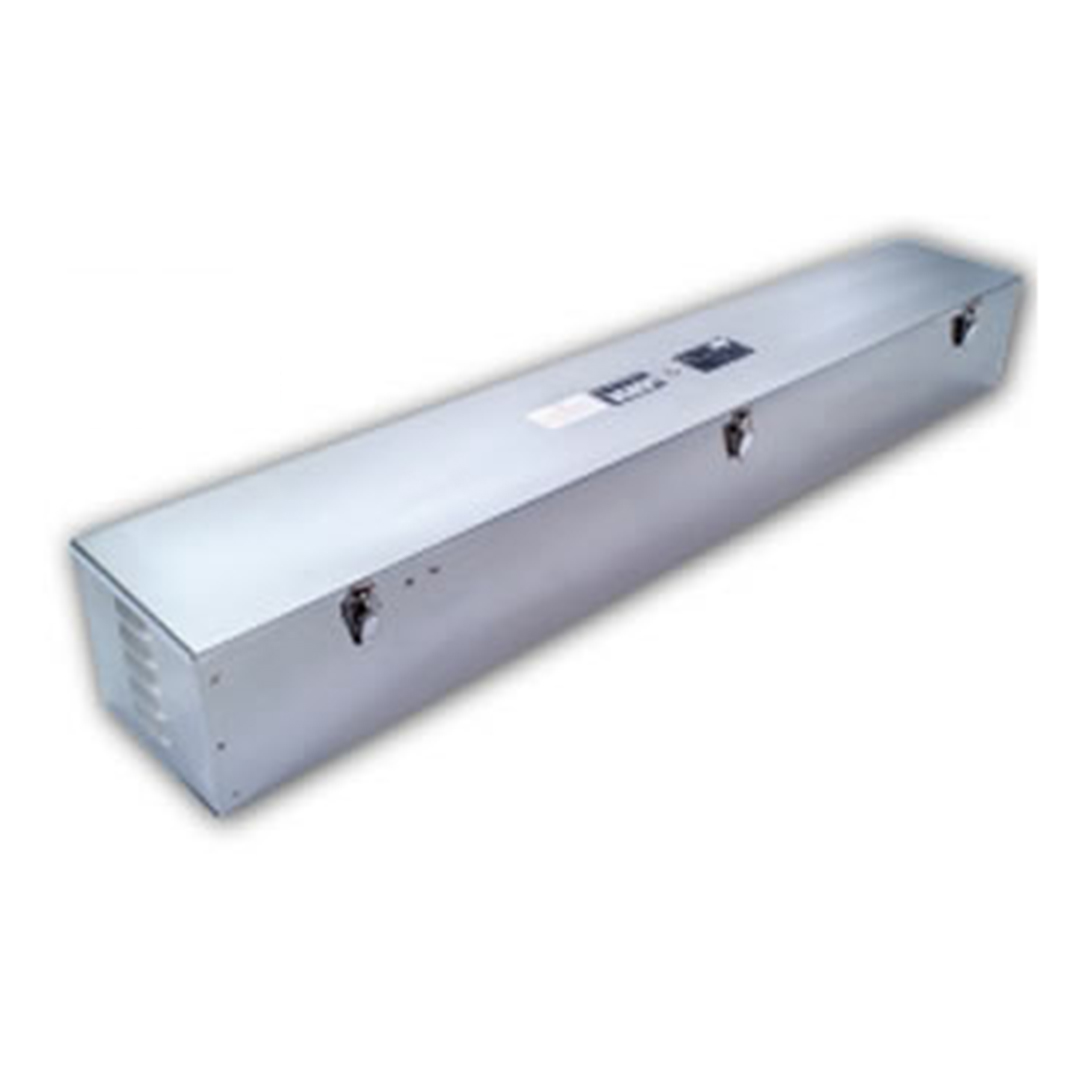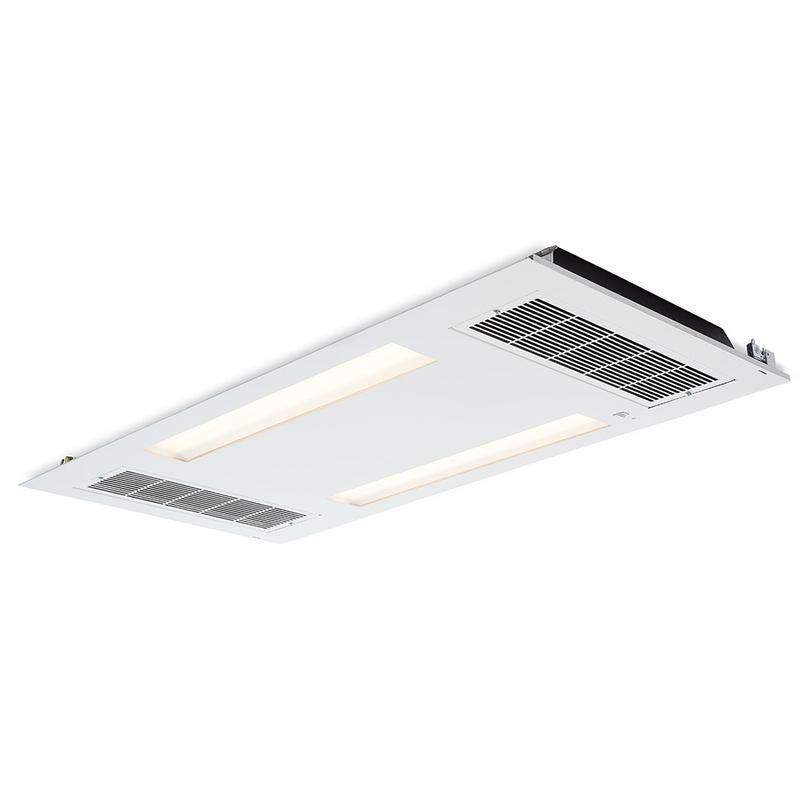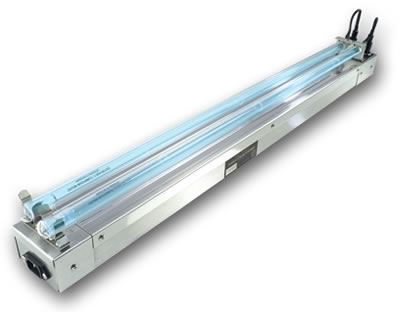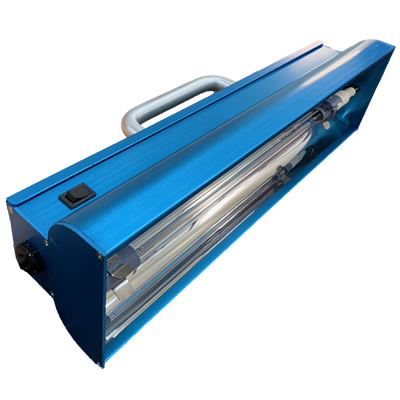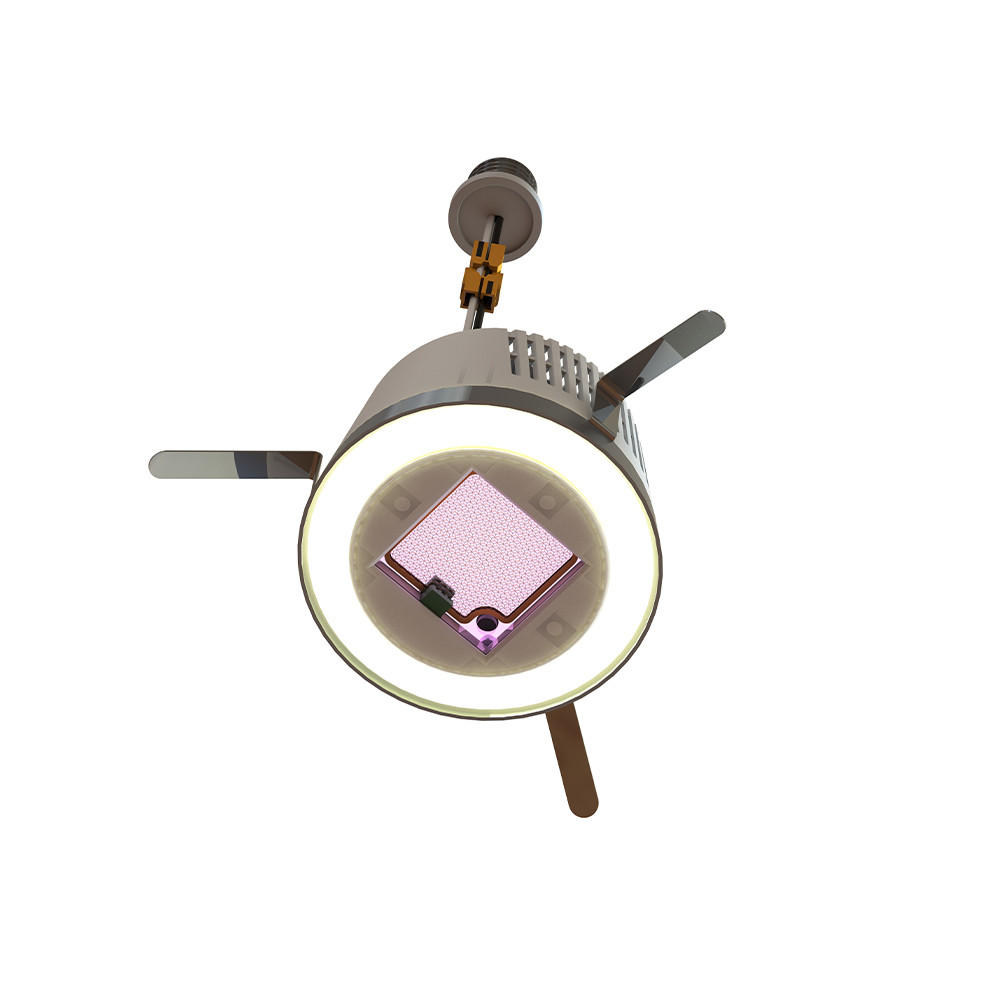How does UV light kill viruses like COVID-19?
Before the COVID-19 pandemic, how much did you know about germicidal UV? Had you ever considered using ultraviolet lighting products?
The virus outbreak brought a new meaning to disinfection and protection. Personal protective equipment like masks and gloves are now part of our normal routine. Cleaning surfaces is happening much more often. And now there is a focus on ultraviolet (UV) light.
Some hospitals have used UV products for decades to disinfect operating rooms. But UV products are not just for use in hospitals anymore. UV is a tool that all industries can use and benefit from.
In this article, we will explain the basics of UV light, how it works, and how it can be effective during and after the COVID-19 pandemic. UV fixtures are a tool that can help your business now and for years to come, as it kills many more pathogens than just viruses.
We primarily used two trusted resources for our information: The Illuminating Engineering Society (IES) and the International Ultraviolet Association (IUVA). Experts in infectious diseases and lighting contributed to reports from both organizations on UV use during COVID-19.
Their reports can be found here:
If you’d like to skip ahead to certain sections, click one of the links below:
- What is ultraviolet light?
- How does UV light kill pathogens?
- How does germicidal UV disinfect air?
- How does germicidal UV disinfect surfaces?
- Can UV kill COVID-19?
- Is UV-C safe?
- Shop for germicidal UV products
What is Ultraviolet Light?
Ultraviolet light is actually not light. The ultraviolet spectrum falls just outside of the visible light spectrum, between the wavelengths of 10 and 400 nanometers. However, “UV light” has become a common way for lighting companies and even scientists to refer to the use of UV energy.
Over decades of studying, scientists have found that different wavelengths of the ultraviolet spectrum perform differently. The UV spectrum is divided into UV-A, UV-B, and UV-C. UV-A and UV-B are commonly used as blacklights and in tanning beds. These are also the UV wavelengths from the sun that penetrate the Earth’s ozone layer. UV-C never makes it to the Earth’s surface.
Scientists discovered that UV-C has disinfecting properties that UV-A and UV-B do not contain. So, when we’re talking about disinfection, we’re referring to UV-C, also called germicidal UV. The downside to UV-C is the safety risks involved. If someone is exposed to UV-C rays, it could burn the eyes and skins. Most fixtures should run when no one is nearby.
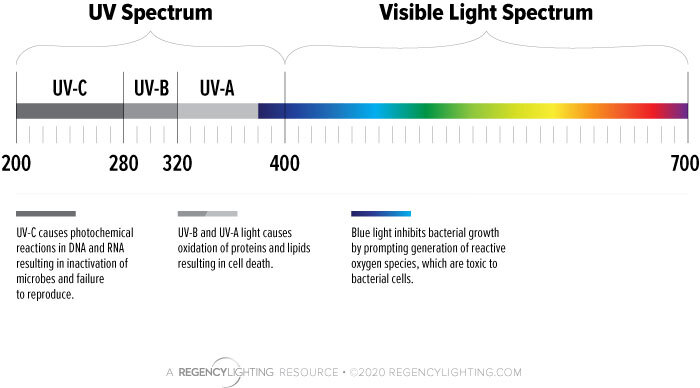
UV-B does have some disinfectant properties, but there is a higher risk associated with exposure, and it cannot kill the same level of bacteria and viruses as UV-C.
There is another part of the UV-C spectrum that has received a lot of attention lately. In the last decade, scientists have started to focus on particular wavelengths of UV-C, specifically 208 to 222 nanometers (nm). This is called “far-UVC.”
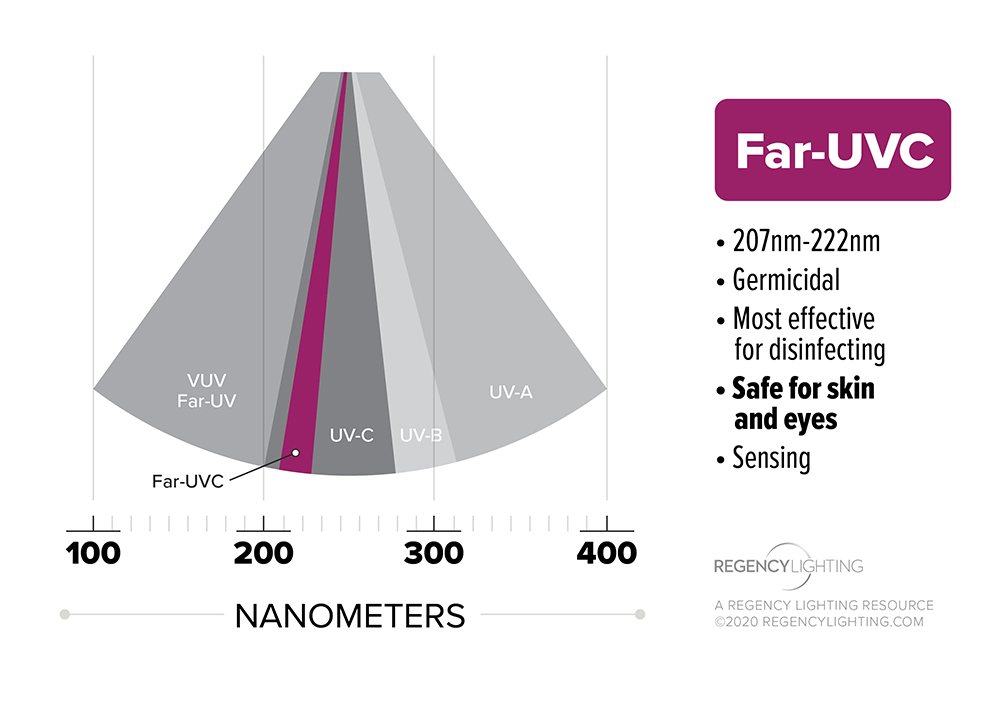
In most studies, scientists have found that far-UVC carries the same level of disinfection as the rest of the UV-C spectrum but does not have the same side effects. In fact, many studies found there is no side effect to the skin or eyes if you are exposed to far-UVC light.
While this technology is somewhat still developing, there are a number of far-UVC products on the market right now.
You can read more about far-UVC and other germicidal UV studies here.
How does UV light kill pathogens?
UV actually destroys bacteria and viruses so they can’t replicate. It may sound like something out of science fiction, but here’s how it works:
- DNA and RNA in cells absorbs UV-C energy
- UV-C damages the DNA and RNA by creating “dimers” or “double bonds”
- That damage causes a mutation that prevents pathogens from replicating
- When viruses and bacteria can no longer reproduce, they die
This is not achieved by all types of UV light. A product must emit germicidal UV (between 200 and 280 nanometers) in order to get rid of as many pathogens as possible.
Even though we are specifically focusing on viruses and bacteria, UV kills many more pathogens including mold and fungal spores.
Fungal spores are relatively hard to kill compared to many other organisms, but high doses of UV can kill fungi. That’s why it’s a great option for HVAC systems. It not only cleans the air, but it also disinfects the system and keeps fungi and other bacteria from growing.
Some cleaning products (like bleach and hydrogen peroxide) can also be extremely effective against pathogens, so you might wonder what separates UV lighting products from a normal cleaning routine. UV lighting products can hit surfaces that might be missed by a normal cleaning. Plus, UV rays can destroy airborne pathogens (not just surfaces).
However, UV fixtures are not a substitute for standard cleaning procedures. Even though UV can disinfect air and surfaces, it cannot penetrate certain particles. It’s important for areas to be dust-free before UV products run their cycle.
One other note on this topic. Germicidal UV kills bacteria and fungi, which are scientifically considered living organisms. Viruses are technically not living, so instead of saying “kill,” it’s more scientifically accurate to say UV products “inactivate” viruses.
How does germicidal UV disinfect air?
Disinfecting air in a building is one of the top ways to reduce transmission of pathogens like COVID-19 and other viruses and bacteria.
There are two methods of germicidal UV that specifically disinfect the air in a building: Upper-room germicidal UV and UV fixtures for HVAC.
Upper-room germicidal UV actually emits UV-C rays above our heads. Fixtures are installed in buildings with ceilings at least seven feet high or taller. Because the UV-C light is not directly pointed at someone, upper-air fixtures can be used and operated safely in an occupied room.
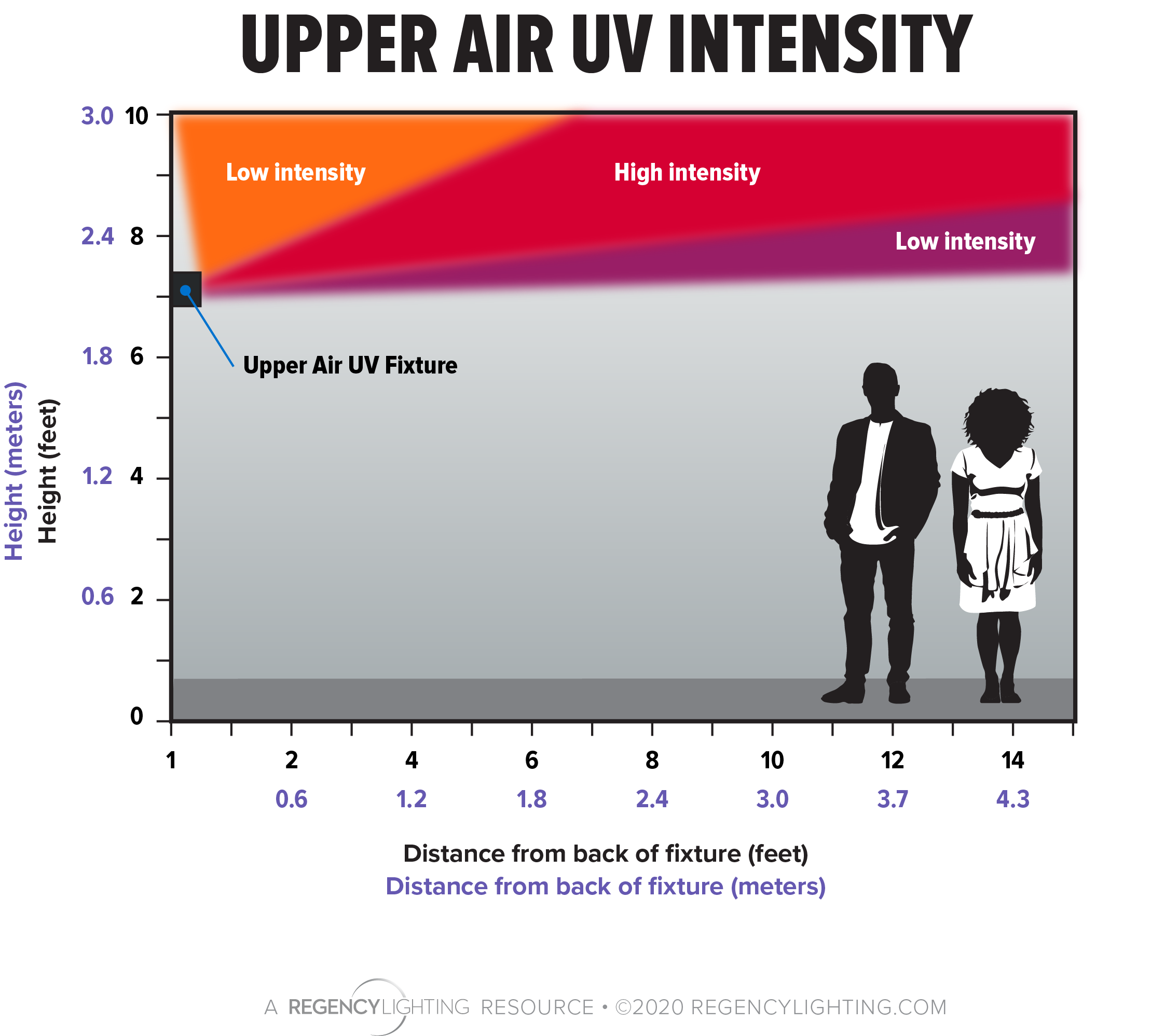
Since the UV doesn’t hit all the air in the room at once, you might wonder how it’s effective. Air naturally moves from lower space to upper space in a room, and vice versa. How quickly that change occurs is called air changes per hour (ACH). Fans or HVAC systems enhance the ACH in a room. So even though the upper-air fixture is only pointed in the upper area of a room, all of the air will likely be disinfected multiple times an hour. One South African study found up to 24 ACH, resulting in a high level of air disinfection.
You can read more about upper-air and how it works in this article.
Germicidal UV fixtures for HVAC equipment can either be installed on the coils or in the ducts of a system. These fixtures disinfect the air entering and circulating throughout the building. They also help improve the life of the system, reducing the amount of mold and fungus that can easily build up on systems.
You can read more about germicidal UV fixtures for HVAC equipment in this article.
How does germicidal UV disinfect surfaces?
People often pick up a virus or bacteria from a dirty surface, so keeping them germ-free is important in limiting the spread of pathogens.
Many germicidal UV fixtures that disinfect surfaces will also disinfect any airborne pathogens in its path. Anything the UV-C light reaches will receive a dose. If UV-C light is blocked by any object either on a surface or in a room, then the dose received is impacted. Any pathogen not in the direct path of the fixture will not be disinfected.
For this reason, you may need to run multiple cycles within the same room. Changing the position or angle of the fixture between cycles can ensure that you are hitting as many surfaces as possible.
There are four main types of UV fixtures that target surfaces: mobile units, installed units, table-top units, and hand-held units. All of these units, unless they emit far-UVC, are not safe for people.
With mobile units, you have the flexibility to move them from room to room or area to area. However, they require labor. You can read more about the pros and cons here.
Installed units can be either ceiling-mounted or wall-mounted. Many of these units run on a timed cycle, but they can also be turned on with a switch.
Table-top units are typically ideal for smaller spaces, but you have the benefit of placing them almost anywhere.
Hand-held units are used for disinfecting small personal items, like cell phones. However, there is a warning about many of these products. Because they are smaller units, they are often less powerful. Simply waving the device over your cell phone will not result in a high level of disinfection. The IES warns that they may provide a “false impression of effective disinfection.”
If you’re looking for a handheld device, we recommend using The Blade by American Ultraviolet (safety glasses are included with purchase).
If you have questions about how surface disinfection works or the best type of fixture for your application, please contact us to speak with a lighting specialist.
Can UV kill COVID-19?
The short answer is yes, in laboratory settings.
A Columbia University scientist recently announced that he used UV-C to inactivate SARS-CoV-2, the virus behind COVID-19. He is continuing his research and will have it peer reviewed. You can read more details here.
This is a conclusion that many scientists predicted. Studies already showed that UV rays inactivated other coronaviruses similar to SARS-CoV-2, like SARS-CoV-1.
Another good indicator that UV products will work against COVID-19 is the comparison to other tiers, or levels, of viruses. UV light is effective against other harder-to-kill viruses that are considered a level 1. Coronaviruses are considered a level 3, and much easier to kill than level 1 viruses.
But because this is a novel, or new, coronavirus, the right testing is needed to come to a solid conclusion. According to the World Health Organization (WHO), "Coronaviruses (CoV) are a large family of viruses that cause illness ranging from the common cold to more severe diseases such as Middle East Respiratory Syndrome (MERS-CoV) and Severe Acute Respiratory Syndrome (SARS-CoV). COVID-19 is a novel coronavirus, and a new strain that has not been previously identified in humans."
No matter which viruses or bacteria you are targeting, the effectiveness of UV depends on the right dose. Time, intensity, and distance are all critical in this equation.
You can achieve the same level of disinfection with a product that has a lower intensity but requires more time as you can with a product that has a higher intensity but works very quickly.
When talking about distance, UV products are more effective on surfaces that are closer to the product than further away from the product.
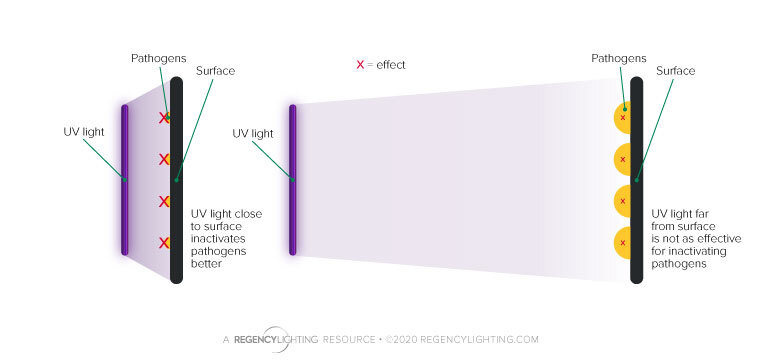
Because COVID-19 infections can be caused by contact with contaminated surfaces and then touching your face, finding the right dose and the right product to cover all areas of your building is key.
Click here to read more about calculating the right dose.
Is UVC safe?
Germicidal UV products are safe when they are used correctly. It is essential to follow all safety and manufacturer guidelines.
If exposure does occur, UV-C can burn your skin and eyes, but it does not penetrate the outer layer of skin. Similar to overexposure of UV-A and UV-V from the sun, you might notice a sunburn-like reaction if you are exposed to UV-C. However, the IES notes that there are no known long-term effects from overexposure to UV-C.
For most products, the highest chance of exposure happens during maintenance on UV products. It’s important to make sure employees handling these products have the proper training and proper safety gear. That can include goggles or shields for the face and eyes, gloves, and full-coverage clothing.
For products like UV wands and table-top units, there may be a higher risk of exposure. You should look for a product with an occupancy sensor that automatically shuts off when motion is detected. You may also want to consider warning signs posted outside of a room while UV products are in operation.
Another safety factor to consider is the lack of regulation and performance standards for UV products. Unfortunately, there are companies that want to take advantage of fear during the COVID-19 pandemic and beyond. You should only buy products from trusted manufacturers with a long track record (at a minimum, prior to March 2020).
You should also look for third party testing and warranties. If the warranty offered is longer than the company has been in business, that is a red flag.
Shop Germicidal UV Products
As more businesses and companies look to utilize UV, the products and technology continue to grow to fit their needs.
We mentioned this is not just for healthcare facilities anymore. Offices, retail stores, restaurants, hotels, sports facilities, and airports can all benefit from UV. Different industries may all have different usage, but now you have multiple options for different types of products.
These products are not only effective against COVID-19. They can also inactivate other pathogens for years to come. Think about flu season. Using UV products may mean fewer sick days for your employees.
Upper-room UV fixtures
Upper-room or upper-air fixtures emit UV rays above people’s heads, allowing the fixtures to run constantly and disinfect the air constantly. Click here to learn more.
While the fixture below operates slightly different from traditional upper-air fixtures, it still disinfects air using UV LEDs.
UV fixtures for HVAC systems
UV fixtures not only help disinfect the air, they can also improve the life of HVAC equipment. Click here to learn more.
UV surface disinfectant fixtures
UV surface disinfectant fixtures can also kill airborne pathogens, but they target every surface in a room. These fixtures can only run when no one is in the room.
Handheld & portable UV fixtures
Handheld and portable UV units are often smaller so they can be used in areas that other fixtures might not cover. They also cover a smaller area or smaller items, so they are not ideal if you are looking for efficient coverage for a larger building. If you’re looking for a lower cost unit for a specific space or application, these products might do the trick.
Mobile UV units
Mobile UV units give you a new level of flexibility. They can be moved from room to room, but they do require labor and may require more than one cycle to reach all surfaces. Click here to look at the pros and cons.
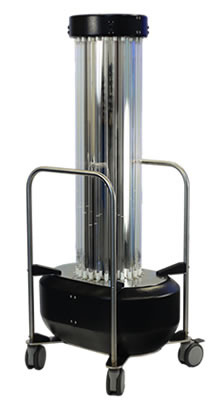
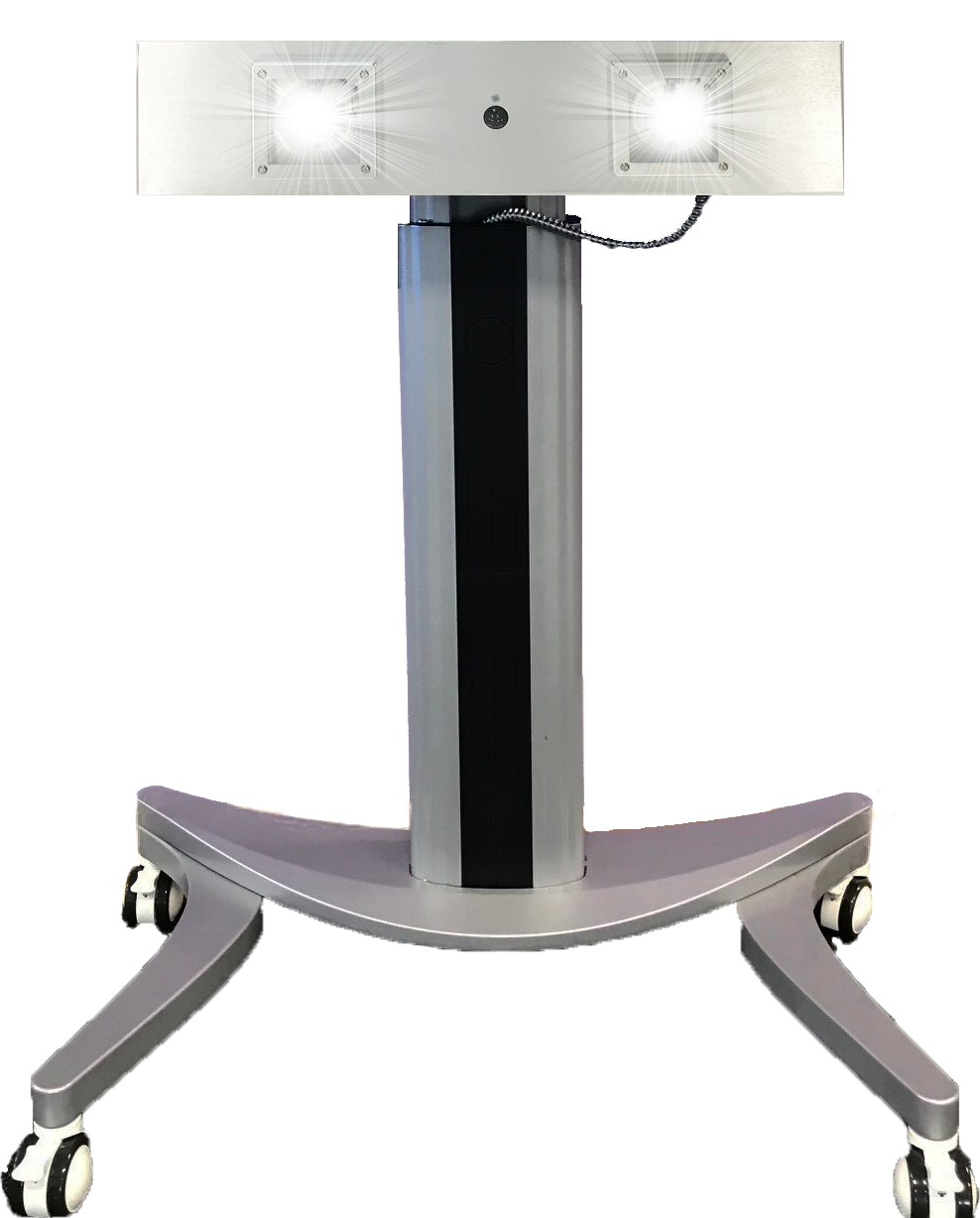
Far-UVC fixtures
Far-UVC fixtures can run constantly because they use the 222 nm wavelength. Many studies have decided that wavelength does not cause harmful effects for humans but can still disinfect.
Questions about UV products
If you have any questions about UV products and how to find the right fit for your application, please do not hesitate to contact us. You can call us, send us a message, or use the chat box in the bottom left corner of your screen. Using UV is just one part of the equation when you are trying to protect employees and customers from COVID-19 and other potential illnesses. We can supply other PPE and disinfection products as well, like the following:
We also have a list of other articles you can read for more detailed information on UV:
- Using UV light to kill viruses like COVID-19
- New research: UV light proven to kill COVID-19
- How to tell if UV light is killing viruses like COVID-19
- Safety and regulation is key for UV lighting products
- Germicidal UV use by industry [During and after COVID-19]
- Does all UV light kill viruses and bacteria?
- 3 ways to use UV light for disinfection
- Germicidal UV for HVAC systems [Pros and cons]
- How much does upper-room germicidal UV cost?
- Mobile UV disinfection units [Pros and cons]
For a full list of solutions we offer during this pandemic and after, click below.
Regency Supply is a family-owned, national distributor with locations across the country. We have more than 40 years of experience in the lighting and electrical industry. The lighting world can be complicated, but we are here and ready to simplify the buying process for you.

